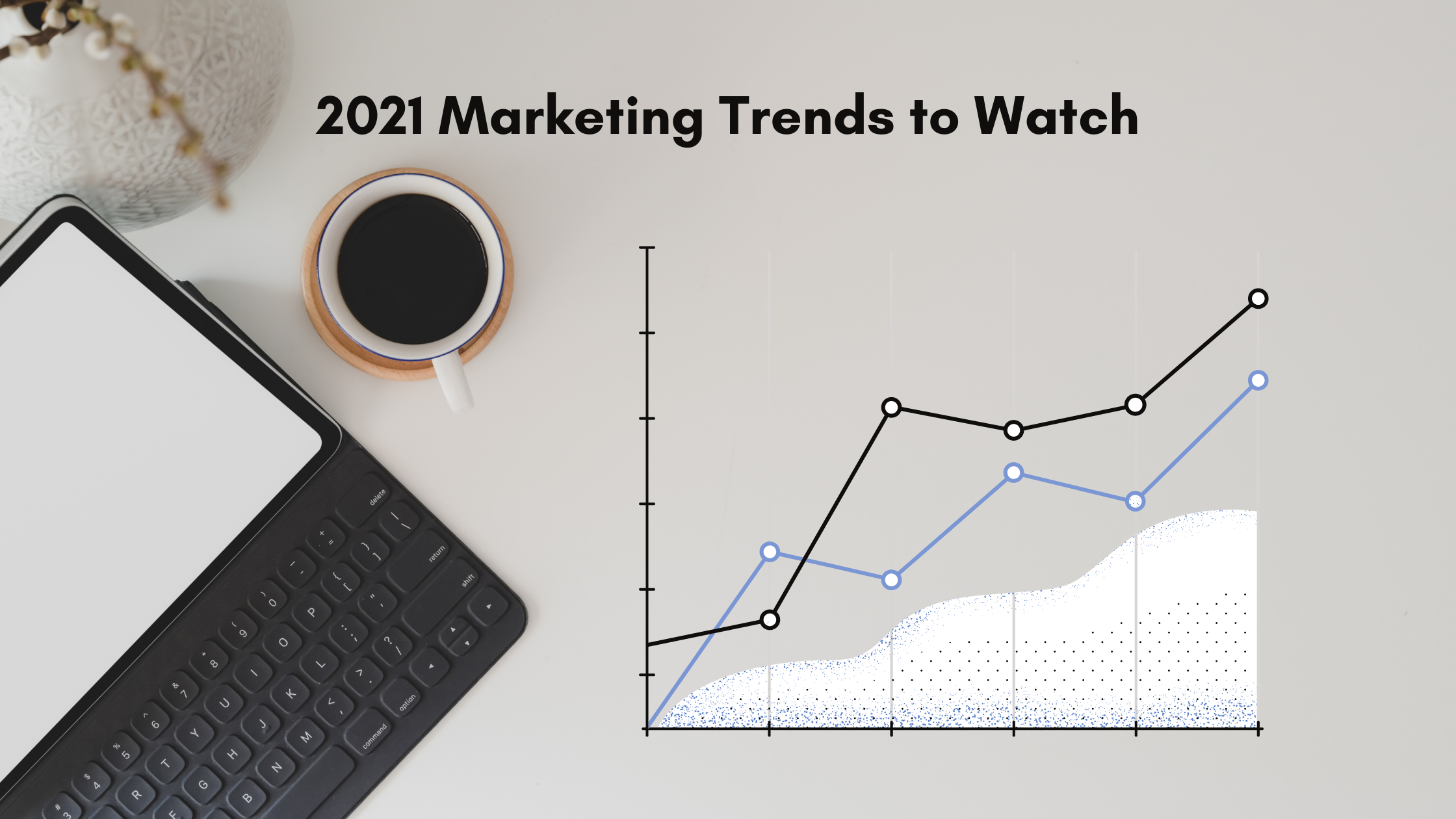2021 Marketing Trends and Predictions for the New Year
As the complicated year of 2020 has come to an end, we’re making predictions on 2021 marketing trends based on the past year and what to expect out of each marketing channel in the year to come.
From saturated to marketing channels to rising stars, we’re going through:
- Telemarketing
- Personalization
- Quality Content
- Search Engine Optimization (SEO)
- Digital Advertising
- Podcasts
- Social Media
- Conferences
This isn’t to say that these are the only elements used in marketing, but rather the more popular channels and what is expected out of them in the coming year.
We’ll break each aspect into a category of effective, ineffective, and neutral based on the way the year played out, and then predict the expected result of the year ahead.
Let’s start with the biggest loser that 2020 brought us.
Kicking off 2021 Marketing Trends
Telemarketing: Ineffective
With more users adopting remote-work, the traditional practice of telemarketing took a major hit. For strategic marketers that had their segmented lists and telemarketers ready to follow-up on their drip-campaigns, a continuously ringing telephone was found on the other end of the line.
That’s not to say that marketing and sales teams weren’t able to generate leads and build awareness from their phone outreach, just that they did so in a more limited fashion when compared to years prior.
So with telemarketing on a downward trend, marketers had a foundational marketing element that they turned to.
We’d expect telemarketing to continue to descend in popularity as 2020 has made marketing teams shift their strategies and ultimately get better.
Email Marketing: Effective
Remote work meant office phones turned to cell phones, but your company email remained intact and business as usual.
You probably noticed more and more marketing emails hit your inbox as the months carried on and marketers pivoted to a form of communication that would still reach their audience at a much higher rate.
The increase in email marketing lead to three things:
- More emails targeting your audience
- Increased difficulty to drive engagement
- Stressed importance of personalization
Marketers had to get creative, do more research, and ensure that their emails were personalized in order to compete for your attention as your inbox filled up.
The initial annoyance of the abundant emails was quickly offset by forcing emails to focus on quality over quantity. Expect this trend to continue into the new year.
Personalization & Creative Marketing: Effective
One of the winners of 2020 has to be personalization marketing. With so many challenges faced and it becoming much more difficult to capture the attention of your target audience, personalization was a major way of standing out.
Whether that be within your emails, digital ads, or print mail, you needed to personalize your content now more than ever to have a fighting chance of grabbing attention.
This caused more backend labor to better understand your target audience, but will ultimately be better for not just your organization, but your target audience.
What does personalization look like? Here are some examples of topics we’ve seen:
- Content built around alumni offerings
- A stronger focus on current events like Hamilton or Mulan on Disney+
- Offerings that tie into popular memes circulating the internet
Personalization and creative marketing will be a core of marketing strategies in the coming year.
Quality Content Marketing: Effective
All of the other marketing elements are ineffective if you aren’t creating high quality content that informs your target audience.
You can be as creative as you’d like and deploy a massive number of emails, but without quality content behind your organization and overall brand, you won’t see much success.
Because we focus on marketing in the 2020’s (big difference from selling), the best way to generate a return on your marketing dollars is to create an inbound funnel of leads that come from your target audience informing themselves on your value before you even speak to them.
Quality content has its place in both inbound and outbound marketing tactics, but will especially pay dividends for your inbound practices over the long term. Quality content can be curated in the form of:
- Text (blogs, whitepapers)
- Video (YouTube, Instagram)
- Voice (Podcasting, YouTube)
This leads us to our next point.
Search Engine Optimization (SEO) Marketing: Effective
To complement quality content and inbound marketing efforts. SEO was crucial over the past year and will continue to play a major factor in the years to come.
We’re in an era where your target audience knows what they want to buy before you tell them what they need to buy. Based on users being able to do their own research and browse the internet for pretty much all of the information they need, they’ll come to you when they’re ready to purchase.
How do you make sure your audience stumbles upon your brand while doing their research and not competitors? Search engine optimization.
As more users consume their information online, optimizing for search will continue to ascend in marketing tactics that your organization should be using.
Digital Ads Marketing: Effective
In a year where budgets were cut and organizations still had to find ways to reach their target audience, digital advertising would’ve helped you accomplish that.
Assuming you were fortunate enough to still have a budget for some paid ads, whether that be Google, LinkedIn, Twitter, Instagram, Etc., then you probably saw less competition due to companies cutting their ad budgets.
This means that you were able to:
- Lower cost per click
- Enhance impressions
- Increase the position your ads were shown as you received more bang for your $$$
A key element of digital advertising is allowing machine learning to complement your efforts over time in order to optimize your ad accounts.
For those that were able to leverage their optimizations and machine learning over the course of the full year in 2020, you’re ahead of the game when it comes to your digital spend in 2021.
Podcast Marketing: Effective
According to Convince and Convert, “In 2020, for the first time, a larger percentage of American consumers listened to podcasts weekly than attended church or religious services weekly: 24% to 23%. 68 million Americans are weekly podcast listeners.”
Again going back to the trend of remote working, more users tuned into podcasts and will continue to do so in the years to come.
Podcasters on the other hand, much like any other element within their marketing strategy, will have to provide high-value discussion around a niche product that they’re experts in to succeed. And that’s not all, they’ll have to do this over time in order to acquire listeners.
With low barriers to entry in the podcasting industry, expect to see an increase in the number of podcasts launched in the year ahead, where the winners will be those that drive highly valuable information to their target audience.
Social Media Marketing: Effective
According to Tech Jury, users spend an average of 2 hours and 24 minutes on social media per day.
We’re stamping social media with an effective rating based on the increasing amount of time that your audience spends on social platforms.
Granted, not all platforms are the same and it’s up to you to determine which demographic spends the most time on specific platforms and how that fits into your business model.
You’re probably tired of hearing this, but over the past year most people spent more time on social media than any other year prior.
This is the easiest marketing element to get started with (it only takes creating an account and making a post) but is increasingly becoming more difficult to capture attention and drive engagement as more and more businesses are trying to tap into their audience with this forum.
This highlights our earlier point, those that can create high quality content to distribute on social media will have a much better chance at driving engagement and growing a following.
Conference Marketing: Neutral
Where we saw physical conferences come to a halt, we’ve seen a surge of virtual conferences.
A neutral rating is being stamped on this one due to the skepticism behind whether or not physical conferences will ever return to their prime dominance, but the birth of virtual conferences has allowed organizations to:
- Do more with less budget $$$
- Tap into larger audiences
- Create time efficiency and give users time back in their schedule
We don’t know that conferences that are full day events will ever be popular again, but we’ve seen businesses get creative in how they drive attendance to virtual events.
Take this example of ‘The Zoom Where it Happens’ where Hamilton cast members perform for an audience.
Businesses have tapped into the Hamilton cast in order to tie into real life events (Hamilton being released on Disney+), entertain the audience, and still set aside time to inform their audience on the value of a solution.
We’re not telling you to go get a Hamilton cast member for your event (that will quickly deplete the budget savings that we were touting earlier), but rather to get creative on entertaining and informing.
Creativity and virtual conferences will be a winner for years to come and is a leading element of our 2021 marketing trends.
All Marketing Channels Can be Effective
Each element that we’ve gone through has received a rating of ineffective, neutral, or effective. This is based on 2021 marketing trends and popularity within the industry, and is by no means indicative of what is happening within your organization.
Frankly, we’ve talked to organizations that find success in traditional practices such as print letters or cold emailing.
Some readers will effectively be deploying telemarketing in the years to come, while others may struggle with search engine optimization.
It’s important to understand that there’s no ‘one size fits all’ combination of these marketing channels, but they’re rather meant to complement one another as you seek to engage, inform, and convert your target audience into customers.
Be sure to measure each channel, determine what is working, and fix what has room to grow regardless of the channel that you’re analyzing.
Reach out and let us know what elements have worked for you, and we’d also love to know what you may agree/disagree with.

Gary McConnell Co-founded Rubicom Digital in 2019 with a goal of providing digital marketing consulting services in the B2B space.
Gary continues to serve as the Marketing Director of a Data Center-focused IT Provider, VirtuIT Systems.

